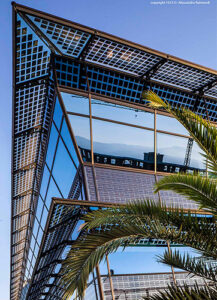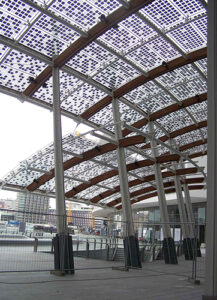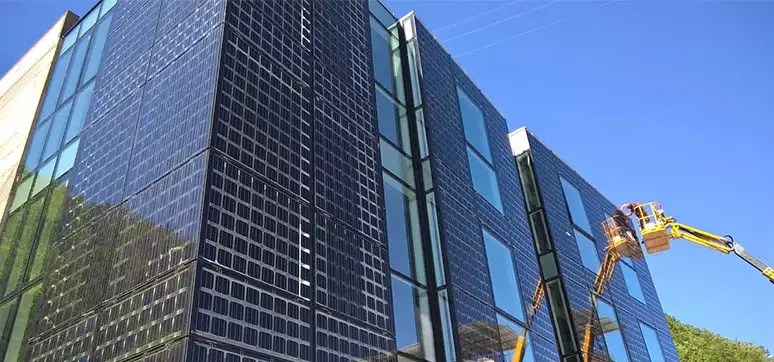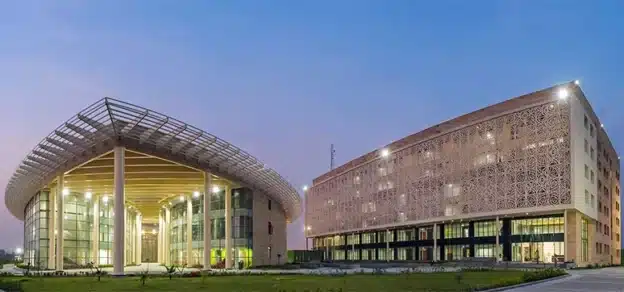Photovoltaic Glass
Building-integrated photovoltaics (BIPV) are photovoltaic materials that are used to replace conventional building materials in parts of the building envelope such as the roof, skylights, or façades. They are increasingly being incorporated into the construction of new buildings as a principal or ancillary source of electrical power, although existing buildings may be retrofitted with similar technology.
The advantage of integrated photovoltaics over more common non-integrated systems is that the initial cost can be offset by reducing the amount spent on building materials and labour that would normally be used to construct the part of the building that the BIPV modules replace. These advantages make BIPV one of the fastest-growing segments of the photovoltaic industry. The term building applied photovoltaics (BAPV) is sometimes used to refer to photovoltaics that is a retrofit – integrated into the building after construction is complete. Most building-integrated installations are BAPV. Some manufacturers and builders differentiate the new construction BIPV from BAPV.

PV applications for buildings began appearing in the 1970s. Aluminium-framed photovoltaic modules were connected to or mounted on, buildings that were usually in remote areas without access to an electric power grid. In the 1980s, photovoltaic module add-ons to roofs began being demonstrated. These PV systems were usually installed on a utility-grid-connected building in areas with centralised power stations. In the 1990s, BIPV construction products specially designed to be integrated into a building envelope became commercially available.
A 1998 doctoral thesis by Patrina Eiffert, entitled An Economic Assessment of BIPV, hypothesized that one day there would an economic value for trading Renewable Energy Credits (RECs). A 2011 economic assessment and a brief overview of the history of BIPV by the U.S. National Renewable Energy Laboratory suggests that there may be significant technical challenges to overcome before the installed cost of BIPV is competitive with photovoltaic panels.
However, there is a growing consensus that through their widespread commercialisation, BIPV systems will become the backbone of the zero energy building (ZEB) European target for 2020. Despite the technical promise, social barriers to widespread use have also been identified, such as the conservative culture of the building industry and integration with high-density urban design. These authors suggest enabling long-term use likely depends on effective public policy decisions as much as technological development.
Types Of BIPV Products

- Crystalline silicon solar panels for ground-based and rooftop power plant
- Amorphous crystalline silicon thin-film solar PV modules could be hollow, light, red blue yellow, as glass curtain walls and transparent skylight
- CIGS-based (Copper Indium Gallium Selenide) thin-film cells on flexible modules laminated to the building envelope element or the CIGS cells are mounted directly onto the building envelope substrate
- Double glass solar panels with square cells inside
Building-Integrated Photovoltaic Modules
-

BIPVs are used to replace conventional building materials in parts of the building envelope such as the roof, skylights, or façades Flat Roofs: The most widely installed to date is an amorphous thin-film solar cell integrated into a flexible polymer module which has been attached to the roofing membrane using an adhesive sheet between the solar module back sheet and the roofing membrane. (Clarification needed) Copper Indium Gallium Selenide (CIGS) technology is now able to deliver cell efficiency of 17% as produced by a US-based company and comparable building-integrated module efficiencies in TPO single-ply membranes by the fusion of these cells by a UK-based company.
- Pitched Roofs: Solar roof tiles are (ceramic) roof tiles with integrated solar modules. The ceramic solar roof tile is developed and patented by a Dutch company in 2012.
- Modules shaped like multiple roof tiles.
- Solar shingles are modules designed to look and act like regular shingles while incorporating a flexible thin-film cell.
- It extends normal roof life by protecting insulation and membranes from ultraviolet rays and water degradation. It does this by eliminating condensation because the dew point is kept above the roofing membrane.
- Metal pitched roofs (both structural and architectural) are now being integrated with PV functionality either by bonding a freestanding flexible module or by heat and vacuum sealing of the CIGS cells directly onto the substrate.
- Façade: Façades can be installed on existing buildings, giving old buildings a whole new look. These modules are mounted on the façade of the building, over the existing structure, which can increase the appeal of the building and its resale value.
- Glazing: Photovoltaic windows are semitransparent modules that can be used to replace many architectural elements commonly made with glass or similar materials, such as windows and skylights. In addition to producing electric energy, these can create further energy savings due to superior thermal insulation properties and solar radiation control.
Advantages Of Photovoltaic Glass
- Electricity produced by solar cells is clean and silent. Because they do not use fuel other than sunshine, PV systems do not release any harmful air or water pollution into the environment, deplete natural resources, or endanger animals or human health.
-

PV systems can be constructed to any size based on energy requirements Photovoltaic systems are quiet and visually unobtrusive.
- Small-scale solar plants can take advantage of unused space on rooftops of existing buildings.
- PV cells were originally developed for use in space, where repair is extremely expensive, if not impossible. PV still powers nearly every satellite circling the earth because it operates reliably for long periods with virtually no maintenance.
- Solar energy is a locally available renewable resource. It does not need to be imported from other regions of the country or across the world. This reduces the environmental impacts associated with transportation and also reduces our dependence on imported oil. And, unlike fuels that are mined and harvested, when we use solar energy to produce electricity we do not deplete or alter the resource.
- A PV system can be constructed to any size based on energy requirements. Furthermore, the owner of a PV system can enlarge or move it if his or her energy needs change. For instance, homeowners can add modules every few years as their energy usage and financial resources grow. Ranchers can use mobile trailer-mounted pumping systems to water cattle as the cattle are rotated to different fields.














